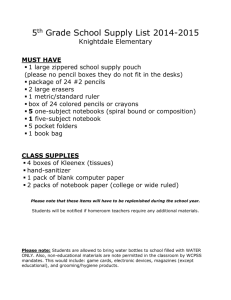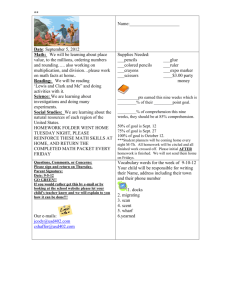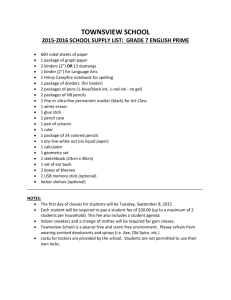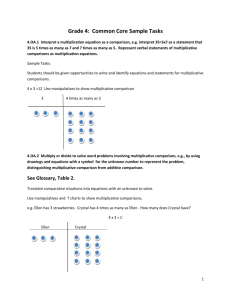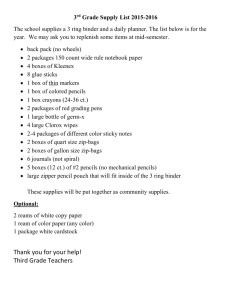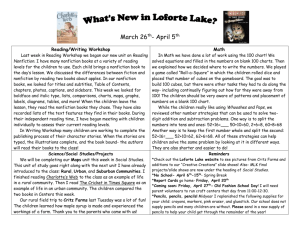Unpacked Math OA Standards
advertisement
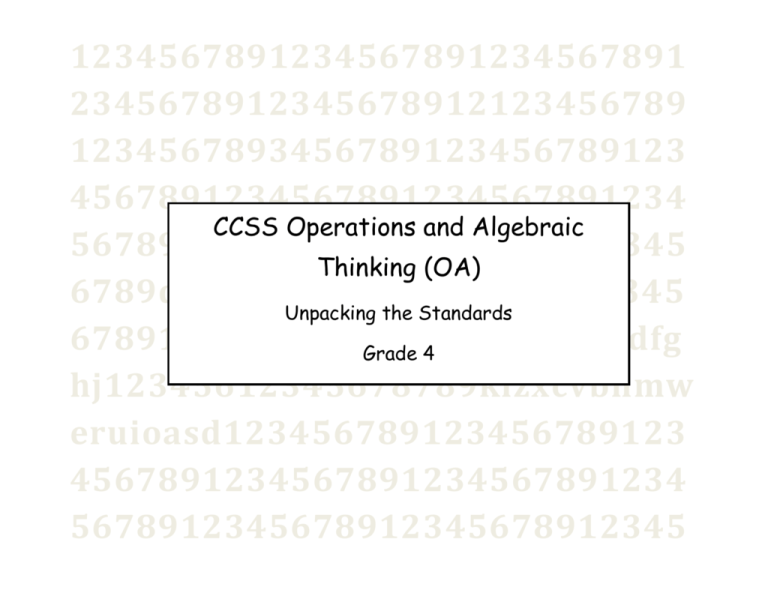
1234567891234567891234567891 2345678912345678912123456789 1234567893456789123456789123 4567891234567891234567891234 CCSS Operations and Algebraic 5678912345678912345678912345 Thinking (OA) 6789qwertyuiopasdfghjklzxc12345 Unpacking the Standards 6789123456789mqwertyuiopasdfg Grade 4 hj12345612345678789klzxcvbnmw eruioasd123456789123456789123 4567891234567891234567891234 5678912345678912345678912345 Math Practices: MP2, MP4 Standard: 4.OA.1 Cluster (m/s/a) Related CA Standard NEW Interpret a multiplication equation as a comparison, e.g., interpret 35 = 5 x 7 as a statement that 35 is 5 times as many as 7 and 7 times as many as 5. Represent verbal statements of multiplicative comparisons as multiplication equations. Essential Skills/Concepts --Recognize a multiplicative comparison problem --Understand the order and meaning of numbers in multiplicative comparison problems (see examples below) --Identify and verbalize all three quantities of the problem OR which quantity is being multiplied (smaller quantity), which number tells how many times, and which number is the product (bigger quantity) --Solve word problems using multiplicative comparisons (see examples below) Examples: a. Sally is five years old. Her mom is eight times older. How old is Sally’s Mom? b. Sally has five times as many pencils as Mary. If Sally has 5 pencils, how many does Mary have? Teaching Notes/Strategies Manipulatives linking cubes two-color chips Use comparison bar diagrams to model problems and show the comparisons Sally = 5 pencils ? pencils ? pencils ? pencils ? pencils Resources ? pencils Use manipulatives (ex: counters, linking cubes) to visually represent objects Have students work in pairs to solve problems using manipulatives Use language to show comparisons (i.e., how many times more, how many times greater) Draw a picture to represent the problem/equation Board Math Cooperative Logic Activities from the book Group Solutions, by Jan. M Goodman (GEMS, Lawrence Hall of Science). Representing multiplicative comparison problems at http://www.k5mathteachingresources.com/ Students create or play a matching game using mult. comparison phrases such as 4 times as many as 2 matches 4 x 2 or 2 x 4 Academic Vocabulary: Use information in the problem to write an equation (i.e., 5 x ___ = 5 OR 5 x m = 5) comparison problems Use equation frames for students to fill in missing information: This shows ___ times ___ ___ times as much is ___ ___ times more is ___ ___ times as many is ____ equation times times more/greater Math Practices: MP2, MP4, MP5, MP7 Standard: 4.OA.2 Cluster (m/s/a) Related CA Standard 4.AF.1.0 Multiply or divide to solve word problems involving multiplicative comparison, e.g, by using drawings and equations with a symbol for the unknown number to represent the problem, distinguishing multiplicative comparison from additive comparison. Essential Skills/Concepts --Recognize an additive and multiplicative comparison problem --Know the difference between an additive and multiplicative comparison problem --Understand the order and meaning of numbers in both types of comparison problems (see examples below) --Identify and verbalize the quantities of the equation --Solve word problems using additive and multiplicative comparisons (see examples below) Examples: a. A blue scarf costs $3. A red scarf costs $6 more than the blue scarf. How much does the blue scarf cost? b. Lane saved $5 from his allowance. Michael saved nine times of Lane’s amount. How much did Michael save? Teaching Notes/Strategies Compare the operations of addition and multiplication including phrases used in each type of equation (i.e., how many times more vs. how many more or how much less) Cooperative Logic Activities from the book Group Solutions, by Jan. M Goodman (GEMS, Lawrence Hall of Science). Use comparison bar diagrams to model problems and show the comparisons Sally = 5 pencils ? pencils ? pencils ? pencils Manipulatives: linking cubes two-color chips Board Math Directly teach the word “variable” or “symbol” and it’s use in equations to represent unknown quantities ? pencils Resources ? pencils Use manipulatives (ex: counters, linking cubes) to visually represent objects Have students work in pairs to solve both additive and multiplicative comparison problems using manipulatives Draw a picture to represent the problem/equation using variables/symbols for unknown quantities Use information in the problem to write an equation (i.e., 5 x ___ = 5 OR 5 x m = 5) Sample Multiplicative Comparison problems at http://www.k5mathteachingresources.com/ Academic Vocabulary: Equation How many times more How many more How much less Multiplicative Comparison problems Additive Comparison problems Variable or symbol Standard: 4.OA.3 Cluster (m/s/a) Math Practices: MP1, MP2, MP4, Related CA Standard 4.NS1.4, 4.AF.1.1 MP5, MP6, MP7 Solve multistep word problems posed with whole numbers and having whole-number answers using the four operations, including problems in which remainders must be interpreted. Represent these problems using equations with a letter standing for the unknown quantity. Assess the reasonableness of answers using mental computation and estimation strategies including rounding. Essential Skills/Concepts Fluency of basic facts in all four operations (not essential, but desired) Recognize/Determine the operations/steps that are needed to solve the problem Be able to interpret remainders in a problem Use estimation to check for reasonableness Examples: a. There are 146 students going on a field trip. If each bus held 30 students, how many buses are needed? b. Suppose that 250 pencils were distributed equally among 33 students for a geometry project. What is the largest number of pencils each student can receive? Academic Vocabulary: Operation Equation Variable Teaching Notes/Strategies Resources Use manipulatives (ex: counters, linking cubes, base ten blocks) to visually represent objects Manipulatives linking cubes two-color chips Have students work in pairs to solve multistep word problems using manipulatives Multistep word problems Interpreting remainders Both at http://www.k5mathteachingresources.com/ Draw a picture/diagram to represent the problem/equation using variables/symbols for unknown quantities Use the PUSD Universal Problem Solving Strategy to solve word problems Use error-analysis to determine what was done incorrectly when solving a problem Problem solving strategy anchor chart Board Math Standard: 4.OA.4 Cluster (m/s/a) Math Practices: MP2, MP7 Related CA Standard 4.NS4.1, 4.NS.2 Find all factor pairs for a whole number in the range 1-100. Recognize that a whole number is a multiple of each of its factors. Determine whether a given whole number in the range 1-100 is a multiple of a given one-digit number. Determine whether a given whole number in the range 1-100 is prime or composite. Essential Skills/Concepts Identify (find) the factor pairs for numbers 1 through 100. Recognize that a number is a multiple of each of its factors (Ex: 21 is a multiple of 3 and a multiple of 7 because 3x7=21) Determine multiples for the numbers 1 through 100. Identify numbers 1 through 100 as prime or composite. Know that 1 is neither prime nor composite because prime numbers have exactly 2 factors (itself and 1). Academic Vocabulary: Multiples Products Factors and factor pairs Prime Composite Teaching Notes/Strategies Search systematically for factor pairs by checking each number (2, 3, 4, etc.) until “reversals” in the pairs are found Create Factor trees for prime factorization Alternate Model for prime factorization for the number 180. 180 2 90 5 45 180 = 2 x 3 x 3 x 3 x 5 3 9 3 3 1 Using a 100 chart, create the “Sieve of Eratosthones” to find primes (see Teacher Share for this resource/directions.) Use a multiplication chart to find multiples and factors Draw arrays for factor pairs Write out factor pairs in a “T” table Use skip counting (by 3’s, 5’s, etc.) to find multiples Resources Manipulatives: Two-color chips 100 charts Anchor charts of the factor tree and the alternate model. Multiplication charts Finding Multiples Prime Number Hunt Common Multiples Least Common Multiple Find the Factor are available at http://www.k5mathteachingresources.com Math Practices: MP2, MP4, MP5, MP7 Standard: 4.OA.5 Cluster (m/s/a) Related CA Standard Partial 7.AF.1.1 Generate a number or shape pattern that follows a given rule. Identify apparent features of the pattern that were not explicit in the rule itself. For example, given the rule “Add 3” and the starting number 1, generate terms in the resulting sequence and observe that the terms appear to alternate between odd and even numbers. Explain informally why the numbers will continue to alternate this way. Essential Skills/Concepts Understand patterns and explaining the reasoning behind a given pattern (i.e., examine a dot pattern in which each design has 4 more dots than the previous one and then reason about how the dots are organized to determine the total number of dots in the 100th design) Generate and analyze number and shape patterns following a given rule Analyze the results of a pattern using a given rule and explain why the pattern of the results will continue. Sample Problems: a. There are 4 beans in a jar. Each day 3 beans are added. How many beans are in the jar for each for the first 5 days (Make a table) b. Complete the table using the rule g=m + 14 c. Fill in the missing number in this sequence 1, 2, 4, __, 16, 32 Teaching Notes/Strategies Resources Examine varying types of patterns and explaining the reasoning behind a given pattern (Ex: patterns using dots, numbers, real objects, colors, shapes which include “growing” and multioperational patterns, etc. See Resource column ) Manipulatives: Two-color chips Have students extend a given pattern and explain reasoning (i.e., give the 20th term in the pattern) by using an equation “Patterns that Grow” available at http://illuminations.nctm.org/ LessonDetail.aspx?ID=U103 Use the “Bridge Map” (see Thinking Maps) to break down and analyze patterns. Anchor charts for tables with patterns and Bridge Map analyzing a pattern 2 +2 4+2 6 +2 8+2 10 Rule = +2 Have students generate patterns and write a rule for the pattern Use a table and function input-output tables to map out patterns and find or follow the rule with and without algebraic notations (f, x, y) Use patterns in real-life situations (i.e. house numbers, growing earnings, etc.) “Pattern a Day” or Number Talks problem to analyze/solve. Examples of problems: “Double Plus One” available at http://illustrative mathematics.org/standards/k8# Board Math Functions Foldable Chart (Toni Torres) Square Numbers and Triangular Numbers available at http://www.k5mathteachingresources.com Academic Vocabulary: Pattern Sequence Term Rule (mathematical definition)
